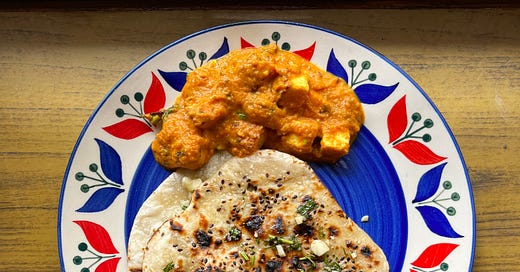Hey there! My name is Apoorva Sripathi, I’m a writer, editor, and artist. This week’s paid subscriber newsletter is a recipe for making a soft and pliable naan that’s vegan and requires minimal ingredients. I hope you’ll give it a go!
Naan is the best flatbread hands down. I see your rotis and chapathis, flaky parathas and sheer rumali rotis (which come a close second), but tearing apart a charred naan that’s flexible from hours of fermentation is like bubblegum for adults. Well, it was bubblegum for me, because even as child I never liked the stuff. But naan I was fascinated with: topped with coriander, and tiny bits of garlic that would roast in the hot butter. And by the time it was brought to our table at a restaurant, cut along a diagonal and inside a basket wrapped in silver foil, the gliding butter would’ve flowed through the naan’s crackled surface coming to rest in its own pool.
What I’m most fascinated about the naan is its storied history shared between countries that also share other vagaries when it comes to flatbread. In Rachel Laudan’s Cuisine and Empire, she illustrates the spread of root and grain cuisines by 2000–1000 BCE: “Two of these, barley and wheat bread cuisine and millet granule cuisine, supported cities in Mesopotamia, the Nile Valley, the Indus Valley, and the Yellow River Valley,” she writes. Early bread was also portable and flat, perhaps because the thinner the dough, the easier it was to cook “directly on the embers or on hot griddles or bake stones”. The shaobing, for instance, is said to derive from the naan that was likely brought by Iranian traders and refugees to China during the Tang Dynasty.
Naan, which comes from the Persian nân (or the Farsi نان) translates simply to bread, and is borrowed by the Indian subcontinent1 (and spread elsewhere) to now refer to a specific type of flatbread. The Persian-style of flatbread is often sprinkled with sesame seeds and baked by deftly sticking it to a curved wall of cylindrical oven called the tandoor. The roots of the tandoor is equally fascinating and extensive so I’ll set it aside for now.
What I’d like to explore instead is indulgence. Because I don’t develop recipes for a living, making naan was incidental; it was to appease my bourgeoning appetite. I had a craving for it after my mother bought a packet of readymade naans from the nearby grocery store. I thought I could make a better version. And so this is how I cook — by honouring my cravings and thereby, honouring my body. And by honouring my body, I nourish it. The more I think about the path that lead to making naan, the more I realise that it was fortuitous.
Keep reading with a 7-day free trial
Subscribe to shelf offering to keep reading this post and get 7 days of free access to the full post archives.





